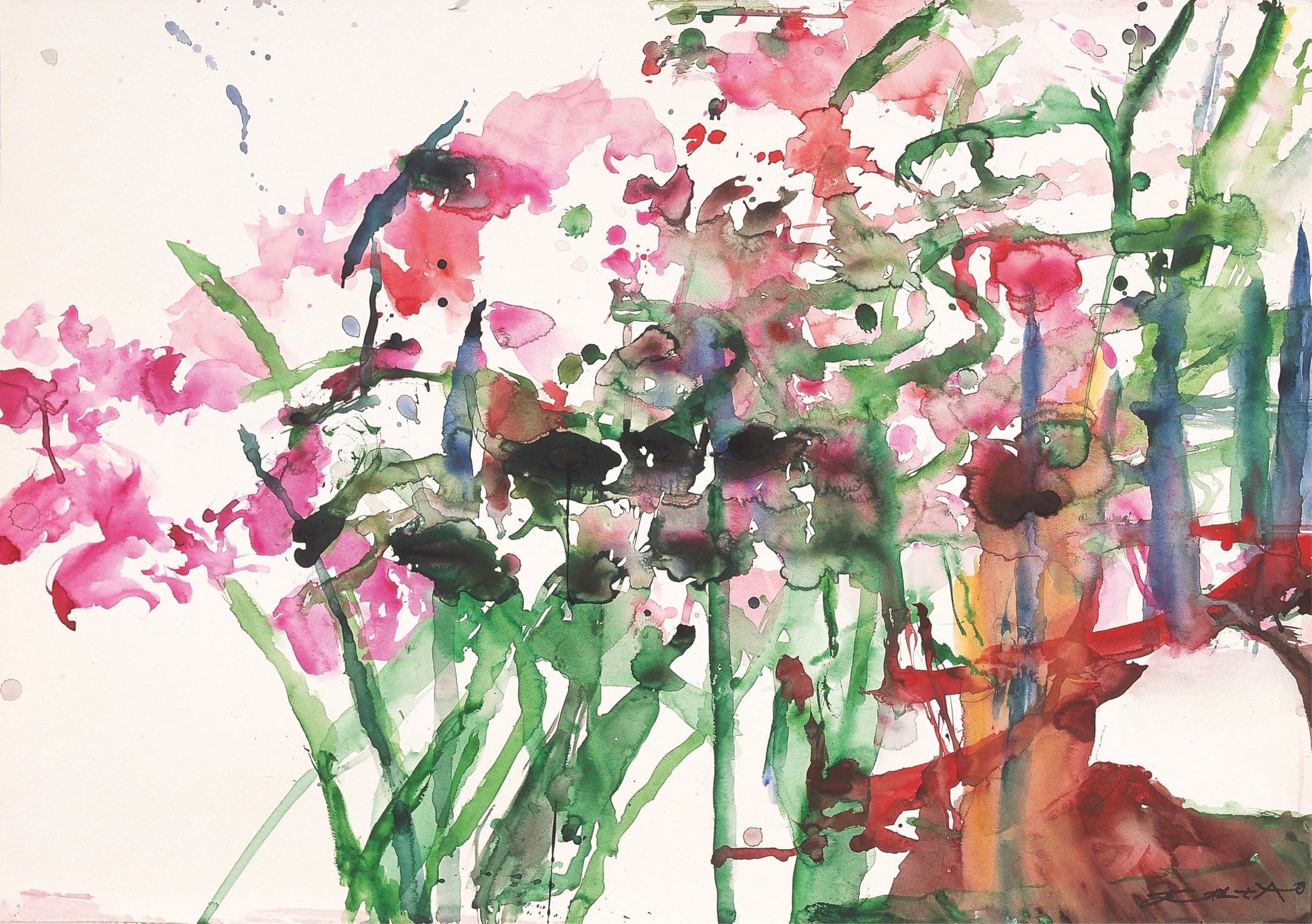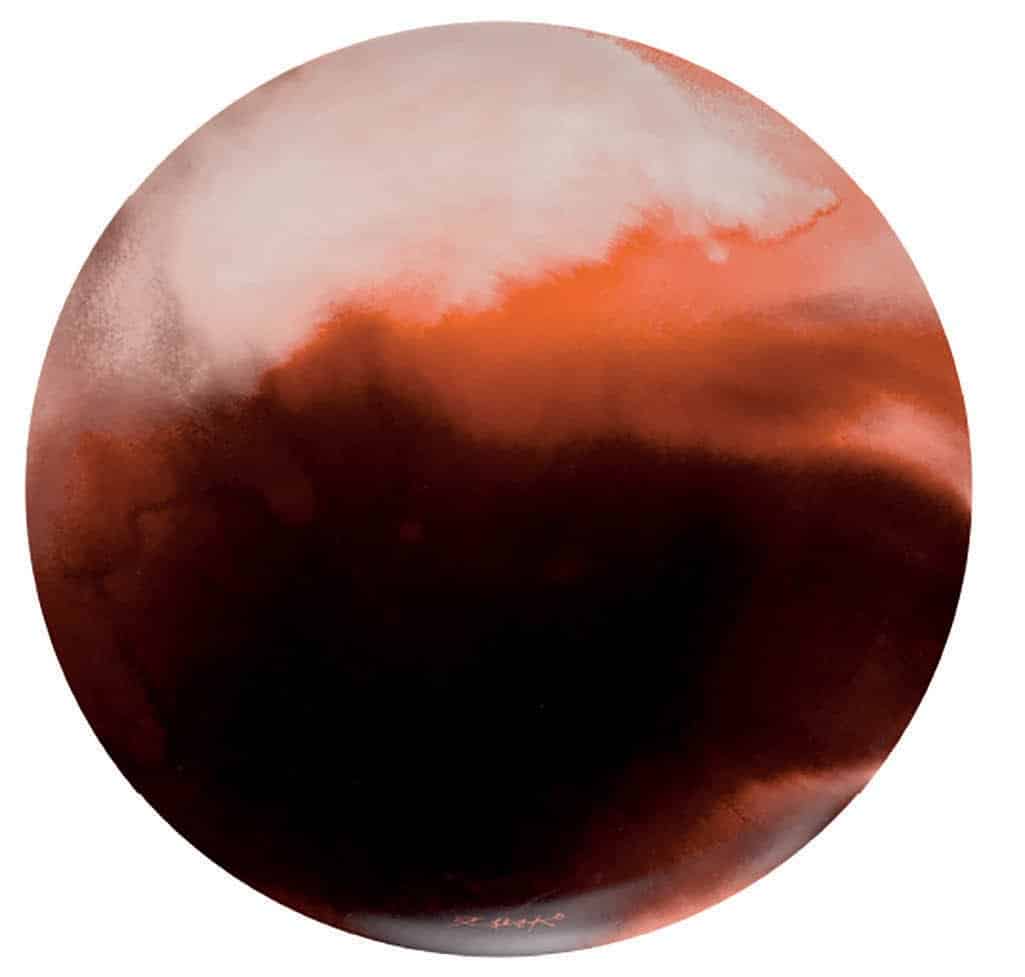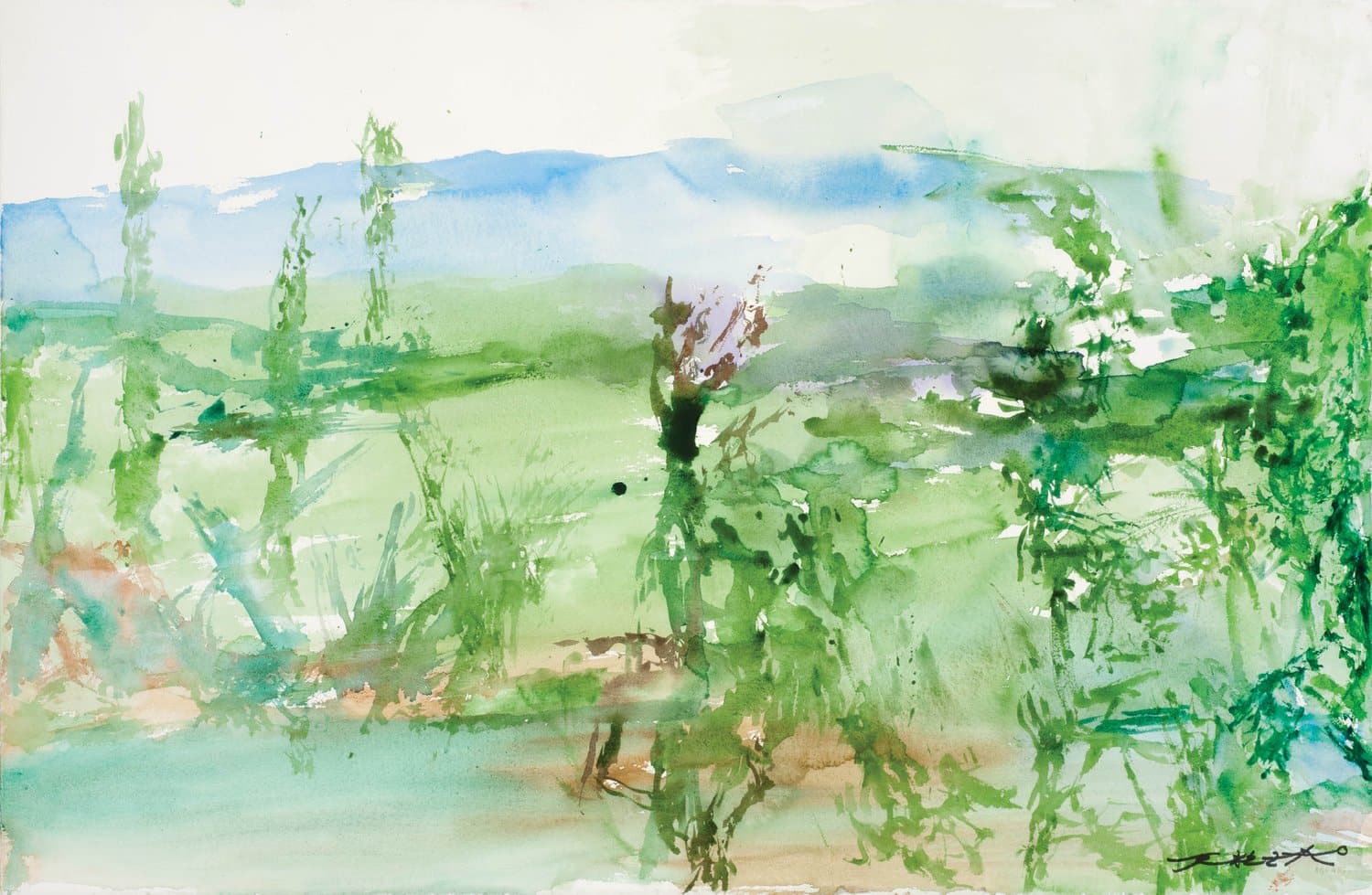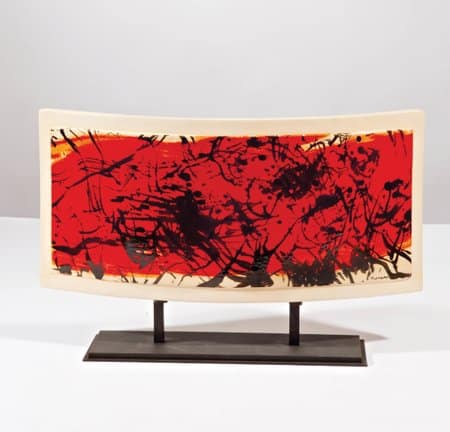
媒体评论 15.05.23
Memphis Magazine, « Without Limit » par Abigail Morici

IMAGE COURTESY OF THE DIXON GALLERY AND GARDENS
Zao Wou-Ki (Chinese-French, 1920-2013), Untitled (Paris), 2008; Watercolor on paper; Private collection, Switzerland © Zao Wou-Ki – ProLitteris
In 2018, Zao Wou-Ki became the world’s third best-selling artist, after Picasso and Monet, with auctions of the late French-Chinese painter’s work generating $327 million, according to Forbes. Now, he sits at a comfortable 23rd ranking, above names as recognizable as Botticelli, Degas, Renoir, Banksy, O’Keeffe, Manet, Pollock, and Matisse, among others. Yet, as Julie Pierotti, a curator at The Dixon Gallery and Gardens, says, he’s not a household name in the United States. Even so, with its latest exhibit, “Zao Wou-Ki: Watercolors and Ceramics,” the Dixon is hoping to change that, with an impressive display of 80 works in watercolor and on ceramics, all drawn exclusively from European private collections.
Born in 1920 in Beijing, Zao drew and painted from a young age, eventually studying at the prestigious School of Fine Arts in Hangzhou, where the founders advocated for the blending of Chinese and modern Western art. Though this sentiment would later become a part of Zao’s legacy, he initially leaned more heavily on Western modernism for inspiration, his early oil paintings revealing his admiration for post-impressionist Cézanne, Fauvist Matisse, and cubist Picasso. He rejected the classical conventions of Chinese landscape paintings and calligraphy, the tradition his grandfather tried to instill in him by teaching him how to draw the characters of the Chinese alphabet. He didn’t want to be stereotyped as a Chinese artist, unable to break into the sphere of Western culture.
And so, by the 1940s, with the hopes of immersing himself in the European art tradition he so admired, Zao moved to France, where he would call home for the rest of his life. Once there, in the aftermath of World War II he discovered his contemporaries had turned to abstract expressionism, a movement begun in New York that upheld spontaneity and improvisation in rendering reflections of emotions. He absorbed this new style easily, the quick, fluid gestures reminiscent of the calligraphy his grandfather once taught him, and soon, as he embraced abstract expressionism, he found himself saying, “Calligraphy is the original source and only guide for my painting.”
“Although the influence of Paris is undeniable in all my training as an artist, I also wish to say that I have gradually rediscovered China,” Zao said in a 1962 interview with the French magazine Preuves. “Paradoxically, perhaps, it is to Paris that I owe this return to my deepest origins.”

IMAGE COURTESY OF THE DIXON GALLERY AND GARDENS
Zao Wou-Ki (Chinese-French, 1920-2013), Firestone Plate, 2004; Bernardaud Manufactory, Limoges Porcelain with lithograph after a watercolor by the artist; Private collection, Switzerland © Zao Wou-Ki – ProLitteris
In fact, Pierotti says, “With abstract expressionism, several artists would say Chinese calligraphy is an inspiration for them.” For Zao, though, this calligraphy was more than an inspiration, more than a jumping-off point unlike other abstract expressionists of his time; it was innate, almost irresistible in its persistence to take over the canvas.
“I think I can say that painting with marks is a Chinese invention, but Chinese painters have never taken it seriously,” he once said, “and for a long time I was mistrustful of the facility that came to me from my long apprenticeship in calligraphy. It had remained an exercise in style, a kind of virtuoso demonstration that I mistrusted. But, despite this feeling to which I became increasingly indifferent, I went on. I saw spaces come into being, made or unmade according to my whim, in an invasive impression of lightness: lightness of brush and color, the lightness of the moment, of time passing. And as I arranged those marks, the living of life became lighter and the pleasure of those gestures prevailed over the traces in my memory.”

IMAGE COURTESY OF THE DIXON GALLERY AND GARDENS
Zao Wou-Ki (Chinese-French, 1920-2013), Untitled (Saint-Tropez), 2007; Watercolor on paper; Private collection, Switzerland © Zao Wou-Ki – ProLitteris
Throughout his prolific career, Zao employed these calligraphic marks in oil on canvas, ink on paper, lithography, and engraving, and watercolor, and through it all, he found success. Indeed, his work was lauded by critics in his time as much as it is today. He continues to sell in international markets, he’s had books written about him, and his work, particularly his oils and prints, has been displayed in museums and galleries around the world, both in his lifetime and after. However, for the first time, his watercolors will be taking center stage in a museum setting at the Dixon.
“For an artist who worked in a variety of media but has this kind of little-known dedication to watercolor, we feel like we’re showing, for those people who knew Zao Wou-Ki before, a different side to his career,” Pierotti says, “and for those who didn’t know him, it’s a great time to get to know him.”
The Dixon’s exhibition features watercolors from throughout Zao’s career, but many of the works are from his later years preceding his death in 2013. “Watercolor is a kind of a constant medium for him,” Pierotti says. “He explored watercolor throughout his career, but with a lot of vigor in the last years of his life. He was known really for his oil painting, but these works really are authentic to who he was and what his artistic vision was.”
“The thing about abstraction is, there’s a tendency in all of us to look at these things and try to identify what we’re looking at, and sometimes you can do that kind of clearly. You say, ‘Oh, that’s the edge of a lake,’ or, ‘We’re looking at some reeds.’ Well, sometimes you look at it and there’s nothing to discern from it. But you can just let it sort of wash over you and let yourself feel the work of art. And that’s a lot of what abstract expressionism is about — communicating emotion.”
— Julie Pierotti, Dixon curator
More so than other media, Pierotti says, watercolor translates well from the tradition of calligraphy. It allows one to see the hand of the artist, where the artist guides the brushstrokes, where he lets the paint take over, and where he shows restraint in negative space. “That fluidity, that comfortability, that kind of natural ability to work with fluid pigment is so different from oil paint,” she says. “You’re in control, but you’re also not in control. … Zao has the confidence to let the pigment do what it’s going to do, let the watercolor pool in certain ways, and that’s where the real beauty of the work shines through.“Yet there’s a certain understanding that the whole page doesn’t have to be filled, that you can let the color kind of speak for itself,” Pierotti continues. “That comfortability with negative space is a theme that comes out of Asian art to begin with, not having to fill a whole sheet of paper, a whole canvas. In the case of the watercolors, it really lets the pigments take center stage.”
For the watercolors on display, Zao takes inspiration from nature as evidenced in the organic colors and forms he portrays. He painted by natural light, wanting to see colors in their truest, most natural form. “Although [the works are] not literal at all, they’re not representational works of art,” Pierottti says. “You see the inspiration from nature.
“The thing about abstraction is, there’s a tendency in all of us to look at these things and try to identify what we’re looking at,” she continues. “And sometimes you can do that kind of clearly. Sometimes you look at something and say, ‘Oh, that’s the edge of a lake,’ or, ‘We’re looking at some reeds.’ Well, sometimes you look at it and there’s nothing to discern from it. But you can just let it sort of wash over you and let yourself feel the work of art. And that’s a lot of what abstract expressionism is about — communicating emotion.”
To that point, Zao once said of his turn to abstraction, “No more still lifes or flowers, I am aiming for an imaginary and indecipherable new writing.” Later, he even compares painting and written poetry in his 1988 autobiography, Autoportrait. “In the Chinese tradition, painting and poetry are intimately connected,” he writes. “They both express the breath of life, the quivering of the brush on the canvas or of the hand on the paper as the character is formed. They evoke without representing, they reveal hidden meanings, those of the universe.
“Each word finds its place in a unified whole, it closes upon a whole in which anyone can casually stroll or stop, go backwards or pause for breath. One comes up against a full stop and there is a wonderful moment of silence, like a piece of emptiness in a painting.”
Within these wonderful moments of silence, these imaginary and indecipherable spaces, no confines exist, the interpretations are limitless, and what separates us from one another — time, geography, language — fade away. Perhaps, this vision was Zao’s destiny — his given name Wou-Ki means “no limits” in Chinese.

IMAGES COURTESY OF THE DIXON GALLERY AND GARDENS
Zao Wou-Ki (Chinese-French, 1920-2013), Stele No. 6, 2006; Delille Manufactory Ceramic with lithograph after the original ceramic by the artist; Private collection, Switzerland © Zao Wou-Ki – ProLitteris
Truly, through his artwork, Zao never limited himself, especially as he pursued both Eastern and Western artistic traditions in his style, rather than one over the other. In blending the two, he has shown how they are intrinsically connected — so that separating them is nearly impossible when looking at the gamut of art history. In a 1986 interview with the French radio station France Culture, Zao said, “I do not think we can still talk about Chinese and Western art: This frontier has been totally broken.”
So often mainstream thinking in the West pays little attention to the Eastern influences that pervade cultures worldwide, seeing the East and West as separate entities coexisting rather than commingling. “Zao knew that this separation between the East and the West was false,” Pierotti says. “These art forms are not as different as anyone thinks they are. There is a connection between Chinese art, Chinese calligraphy, and abstract expressionism. There’s a connection between Chinese porcelain painting and European porcelain painting.”
Pierotti references Zao’s ceramics, also on display at the Dixon, which feature Zao’s signature style of calligraphy-inspired abstraction. Commissioned in the late 1970s by Sèvres, France’s national porcelain manufacturer, these ceramics allowed Zao to merge his knowledge of traditional Chinese porcelain painting with the centuries-old legacy of the French factory.
“The Dixon has such a big commitment to ceramics with our porcelain collection,” Pierotti says, “so we’re excited to have this kind of contemporary take on the centuries-old European tradition and even a tradition that goes back much further in Chinese culture.”
In a way, Zao brings new life to both traditions, while showcasing his own style. “The really cool thing about [the ceramics] is that his brushwork is really energetic. There’s a kind of energy in them and the movement in the paintings on porcelain really contrasts with the fragility of the porcelain, the immobility of porcelain. … They’re really quiet but alive at the same time, and I feel like that with all of Zao Wou-Ki’s work, too.”
Ultimately, the Dixon sees this exhibition as a “rare opportunity,” made through the museum’s friendship with Gilles Chazal, former director of the Petit Palais, Paris. As Pierotti points out, these watercolors and ceramics never seen before in a public setting will offer Memphis a unique insight into the influential, boundary-pushing Zao, who bridged the East and the West within his art.
“Watercolors don’t really travel very much to begin with,” Pierotti says. “They’re a more fragile medium, more sensitive to light. But they’re more spontaneous too. They’re really this kind of special medium that artists work in sometimes where you get to be up close and personal with them. You know that this isn’t a work of art that necessarily was labored over a lot; there is some immediacy to them. It’s like the artist puts the brush on the page and you see the mark, you see the pigment. There’s no hiding in watercolor.”
Overall, through the exhibition, Pierotti hopes visitors will gain a new appreciation for the universality of abstraction and the intimacy of watercolors. “The next time you’re looking at an abstract painting — if it’s by a Memphis contemporary artist [like Susan Maakestad, whose watercolors are also on display at the Dixon] or if you’re going to another museum and you see a Jackson Pollock — you might make that connection to what you saw at the Dixon, what you saw in Zao Wou-Ki’s work, and things might click a little bit more for you.”
“Zao Wou-Ki: Watercolors and Ceramics” is on display at The Dixon Gallery and Gardens through July 16th. Accompanying the exhibit is “Susan Maakestad: The Expansive Moment,” on display through July 9th. Admission to the museum is free.
